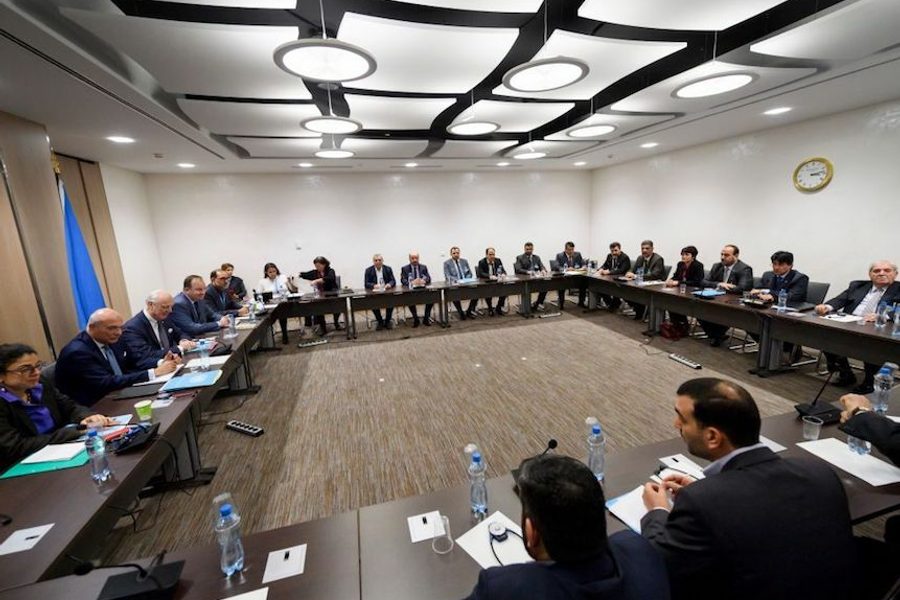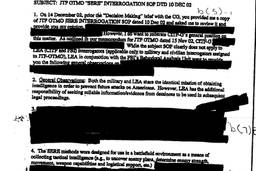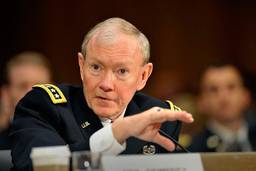Bombs Aren’t the Answer: A Case for Vigorous Diplomacy in Syria, Afghanistan and Yemen
The latest escalation in Syria underlines the need for political, not military, solutions.
Stephen R. Weissman

The United States has intervened militarily in civil wars in Afghanistan, Syria and Yemen to defeat Al Qaeda, associate America with a democratic “Arab Spring” and support the ambitions of friendly Middle Eastern governments. Yet little progress towards these objectives has occurred, partly because American policies were misplaced. Central Al Qaeda has long been located in Pakistan, not Afghanistan, and the Arab Spring proved ephemeral. Meanwhile, intervention has damaged many fundamental American interests. It has strained relationships with U.S. partners, stoked interstate tensions, threatened to plunge the U.S. into new military commitments, burdened America’s complex relationship with Russia, contributed to tremendous losses of human life and aggravated U.S. budgetary deficits.
What to do? Critics of the Obama administration’s “weakness” have urged the United States to double down on its use of force. Though wary of domestic political constraints on further American casualties, the Trump administration has ventured partway in this direction. In Afghanistan, it added a few thousand troops to the 11,000 already present, loosened constraints on American military operations and suspended security assistance to Pakistan over its failure to crack down on Taliban sanctuaries. In Syria, it reportedly ended major CIA covert military assistance to “moderate” rebels, but, after helping subdue the Islamic State in Northern Syria, maintains 2,000 U.S. troops and considerable air power in the region as “leverage” against the Bashar al-Assad regime and Iran. In Yemen, it has escalated military support — arms sales, intelligence and refueling of military aircraft — to the Saudi-led coalition defending the displaced government against Houthi rebels.
Nevertheless, no amount of politically permissible U.S. military escalation will rescue failing U.S. policies. Local U.S. clients suffer from political and military dysfunctions that cannot be alleviated by outside economic and military aid. At the same time, their opponents have been supplied by Pakistan, Lebanese Hezbollah, Iran and Russia with enough resources to avert defeat and even gain ground.
A more promising route to protect America’s political and humanitarian interests exists, but you will not hear much about it from the executive branch, Congressional foreign policy leaders, prominent Washington think tanks and mainstream media. It is to pursue an end to these wars through mediated, compromise political settlements based on ground-level realities — leavened with as much justice and accountability as can be achieved.
Does this sound naïve? It is what the United States did in helping to resolve seven civil wars (in three of which the U.S. military had been involved) between 1990 and 2005 in Bosnia, Burundi, Cambodia, Democratic Republic of the Congo (an interstate as well as intrastate conflict), El Salvador, Mozambique and Sudan. This was an era when the Cold War ran down, enabling U.S. political and opinion leaders to address these conflicts forthrightly. Today, their vision is clouded by fearful overreactions to international terrorism and Iran’s regional rivalries. Still, from 1990 – 2013 a larger percentage of civil wars were resolved by negotiated settlements than by military victories.
The seven wars endured from four to twenty-two years (four lasted at least eight years). Individually, they resulted in anywhere from tens of thousands to, in Congo’s case, 3.5 million military and civilian deaths. But once serious peace talks began, six of the negotiations were completed in less than three years. Every one of these accords was achieved through external mediation among the parties to the conflict. As former Tanzanian President Julius Nyerere told me in 1997, after having led the effort in Burundi for two years, “One thing I know, they can’t do it on their own.”
Each conflict attracted a prime mediator — a regional organization, the U.N., the U.S., even a lay Catholic group — assisted by other governments.] Deploying professional mediator skills and wielding diplomatic carrots and sticks, they helped the parties — and their external supporters — fashion often ingenious political compromises.
All of the peace accords served U.S. foreign policy interests by replacing violent conflicts in sensitive regions with sustainable political arrangements. Certainly, there have been problems in the conceptualization and implementation of many of these settlements, and those in Burundi and Congo are now under strain, but none have broken down into renewed war.
Yet this history is rarely considered, even by progressive leaders, when confronting present-day conflicts. A September 2017 report on Syria policy by the U.S. Holocaust Memorial Museum illustrates the shallowness of contemporary discussion.
The study explored whether the Obama administration had “missed opportunities” to reduce civilian deaths and atrocities in Syria, concluding that any politically feasible intensification of military action would have proved ineffective. Yet it failed to evaluate missed diplomatic opportunities to move the bloody conflict toward a compromise political settlement, thereby accepting the human consequences of the Obama administration’s deployment of large-scale “covert” force to promote regime change. One explanation for this stunning omission is that the report only explored options that were “prominent in the debate” or “seriously considered” by policy makers. That speaks volumes about the blinders surrounding public conversation about American policy options toward foreign civil wars.
There have been no real political negotiations to end the civil wars in Afghanistan, Syria and Yemen, although some mediators have stepped forward. Considering America’s military and political role in these conflicts, its failure to catalyze, participate in or assist any third-party mediation beyond preliminary talks has been quite consequential. It has not, as in earlier conflicts, elevated peacemaking to a priority, and the political solutions it has proposed have more often than not been divorced from political realities.
Certainly, it would not be easy for the United States to help mediate settlements of these three wars. “Hardliners” on both sides of the conflicts, the multiplicity of opposition forces, sectarianism and competing foreign interventions all stand in the way. Moreover, U.S. policy makers fear that their political opponents would accuse them of “giving in” to Russia, Iran or “terrorists.”
Nevertheless, similar constraints were overcome in past mediations. Hard-liners roiled the negotiations in Bosnia, Burundi and El Salvador. In Cambodia, the agreement was imposed upon the resistant parties by their external sponsors. In Bosnia, Cambodia, Burundi and Congo, multiple armed movements were eventually integrated into the settlements. Heritages of genocide and politicide were transcended in Bosnia, Cambodia and, to a lesser extent, Congo and Sudan. Rival foreign powers worked together on behalf of common interests in Cambodia, Congo and Burundi. And U.S. Presidents and Congressional leaders exerted political leadership to overcome serious domestic resistance to the settlements in Bosnia, Cambodia and El Salvador.
A look at peacemaking efforts in the ongoing civil wars casts light on the role the United States could play in promoting negotiated settlements.
Afghanistan: The Never-Ending War
According to Afghanistan expert Barnett Rubin, the “peace process” in Afghanistan has been “a history of mistrust, missed opportunities and power plays.” While both the long-running military stalemate and the lead combatants’ recurrent expressions of interest in a political solution suggest a possible “ripeness for resolution,” no prime mediator has emerged and no serious negotiations have occurred.
A major complication has been that Pakistan — simultaneously the Taliban’s major military supporter and the principal base for the U.S. military campaign — has sometimes opposed negotiations or tried to manipulate the autonomy-seeking Taliban. The United States has not been sufficiently forceful in advocating for a mediated solution. In early 2009, the Taliban signaled the incoming Obama administration that it was interested in talking with the United States — which it considered its real foe — about a settlement. The late Richard Holbrooke, the U.S. Special Representative for Afghanistan and Pakistan, aspired to replicate his successful mediation in Bosnia by bringing together the combatants and involving Pakistan, Iran, India and Saudi Arabia. However, his campaign was stalled by the White House, which focused on a military surge and worried about domestic political reaction to any appearance of “softness.”
It was not until 2013-14 that the U.S. and the Taliban agreed to the establishment of a Taliban office in Qatar and a prisoner exchange. But since then there have been only a misfired Pakistan-Afghan Government-Taliban meeting in 2015 and two Afghan Government-Taliban meetings in September – October 2016.(A spring 2016 meeting had been canceled by the Taliban after its leader was killed in Pakistan by a U.S. drone strike. Some U.S. officials wanted to spare him because he had authorized preliminary talks, but they were overruled).
Like the early Obama administration, the Trump team began by ramping up — though far more modestly — military action. Following a major Taliban terrorist bombing in January, the president declared, “We don’t want to talk with the Taliban. There may be a time, but it’s going to be a long time.” That is a recipe for endless war.
A better course would be to pursue Holbrooke’s idea of a mediated compromise, led by a relatively neutral sponsor like the United Nations or a South Asian regional grouping.
Syria: An Incoherent Policy
The war in Syria was stalemated from 2013 to 2016, but the warring parties failed to notice this because they were repeatedly able to summon additional support from foreign backers. In the last year, Russian military intervention has shifted the balance toward the regime. Yet it is far from certain that the Assad regime will soon be able to regain lasting control of certain key areas, or avoid a draining insurgency. Furthermore, the regime continues to face various military threats from Israel and Turkey and remains vulnerable to oft-promised reductions in Russian assistance.
Although the growing military presence of at least six foreign powers (Russia, Iran, Lebanese Hezbollah, the United States, Turkey and Israel) in Syria complicates the mediator’s task, it also creates new leverage for peacemaking. The intervenors possess common interests in fostering a political solution that satisfies their most basic regional concerns while reducing Islamic extremism, preventing military confrontations that might escalate out of control and conserving military and economic resources.
Unlike Afghanistan, the Syrian conflict has attracted a number of mediators since 2012, most importantly the United Nations, backed by U.S. and Russian-led international groupings including the combatants’ Middle Eastern supporters. Since 2016 U.N. Special Envoy Staffan de Mistura has convened nine rounds of intra-Syrian talks with meager results: agreement on a rudimentary 12-point agenda and reception of legal and technical advice from outside specialists. But, de Mistura laments, real political dialogue has not even begun.
Factors that account for this abortive process include the obduracy of the Syrian regime, which regards the opposition represented as “terrorists”; the opposition’s divisions and insistence on Assad’s immediate political demise; and the passions provoked by the increasingly sectarian carnage.
A less visible obstacle has been the weak, disunited and sometimes ill-conceived performance of the international sponsors, which include the Syrian fighters’ backers. U.N. mediators have publicly complained that they have failed to concert and mobilize sufficient leverage on the contending parties.
In addition, the sponsors’ general prescriptions have been flawed. For example, in 2015, the U.N. Security Council issued a new call for the establishment of “credible, inclusive and non-sectarian governance” within six months and elections under a new constitution within 18 months. This was an impossible calendar given the complexity of the Syrian conflict and the length of time necessary to simply negotiate settlements in recent civil wars.
The Obama administration bears some responsibility. For years, it veered back and forth between military escalation and diplomatic negotiations, never developing a coherent approach towards achieving its objectives. Its fixation with excluding Assad from a prospective transitional government was unrealistic and inhibited cooperation with Assad’s external supporters. Its refusal to accept one of them, Iran, as a participant in international meetings on Syria until late 2015 was also counterproductive. By administration’s end, prospects of a negotiated peace had only worsened.
The Trump team apparently dismantled the CIA’s paramilitary operation but said it was maintaining U.S. forces in Northern Syria to complete ISIS’s destruction, oppose Iranian influence and encourage “post-Assad leadership.” Unlike his predecessors Hillary Clinton and John Kerry, recently-fired Secretary of State Rex Tillerson maintained that the United States was now relying on a Russian-backed, U.N.-sponsored democratic election to displace Assad, and acknowledged this would “take time.” Despite President Trump’s new vow to withdraw U.S. troops within several months, U.S. airpower remains in the region, as does the danger of confrontations between foreign powers in the Syrian conflict that could draw the U.S. in. Witness the war clouds rising after the latest alleged Syrian Government chemical attack on civilians. Now is the time for America to collaborate with these players — both unruly allies and perceived adversaries — to help the U.N. mediator push the internal parties towards realistic compromises.
Yemen: Led by a Client
The shortest-running of these wars (three years), the Yemeni conflict appears stalemated. The U.N. mediator arranged the first face-to-face meeting of the displaced Yemeni government and Houthi-led rebels in December 2015. Agreements were reached regarding a cease-fire, humanitarian assistance and release of prisoners. The parties continued to pursue these subjects in three subsequent rounds of meetings between April and August 2016, but no progress was made towards a political solution. In the end, the frustrated mediator decided to present a “roadmap” for the establishment of a national unity government and security arrangements. But the parties were inflexible, leading the mediator to suspend the talks. While the humanitarian crisis has deepened dramatically, there have been no further meetings in the succeeding 18 months.
Given its critical military support for the Saudi-led coalition backing the government (Iran provides more modest military aid to the Houthis), the United States has considerable leverage to promote a political compromise. Yet neither the Obama nor the Trump administration has tried to use it. Once again, the best U.S. alternative is to support the U.N. mediation, working with the internal parties, Saudi Arabia and Iran to foster a political settlement.
Time To Act
Some Americans might blanch at striving for compromises with “adversaries” like Russia and Iran, much less “unreliable” partners like Pakistan. But U.S. relations with these countries are complex, and common interests have often generated cooperation. Russia invaded Ukraine and conducted information warfare against the United States, but supported America in post-9/11 Afghanistan, the Iran nuclear deal and the battle against ISIS in Syria. It has floated ideas about a political compromise in Syria that have discomfited Syrian President Assad. And while Iran has worked to expand its regional influence in Syria and Yemen, it collaborated with the 2001 U.S. invasion of Afghanistan, negotiated constraints on its nuclear program and combatted ISIS in Iraq and Syria. Its involvement in Yemen has been purposely limited. The challenge for U.S. policy makers is to persuade other powers that they have no more reason than America to prolong these wasting, risky wars since their most basic geopolitical interests can be satisfied within negotiated settlements.
While one might expect liberal Democrats in Congress, media and civic groups to take the lead in pushing for political negotiations to end these bloody struggles, that has not generally been the case. It is well past time for progressives to broaden the public conversation surrounding all three wars, making the argument for a serious and patient pursuit of political solutions. Concerned citizens should support relevant congressional legislation such as recent efforts to curb arms sales and invoke the War Powers Act in Yemen. But they should also go beyond these negative initiatives to advocate positive political solutions — which have the additional virtue of being more politically palatable. As congressional and presidential elections approach, they should insist that their preferred candidates embrace the path toward peace.








